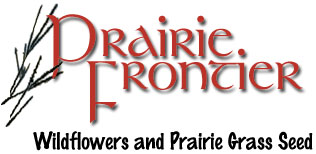
Prairie Types
| PF Home | Native | Prairie Grass | Mixes | Site Map | Prairie Information | Planting Tips | Butterflies | Sales |

|
|
Wet PrairiesSaturated soils are found at these sites through much of the growing season. There is often abundant standing water with soil types ranging from leached sand or gravel to organic peat and muck.Typical PlantsSwamp Milkweed, Blue Flag, Joe Pye Weed, Cardinal Flower, Great Blue Lobelia, Boneset, Thickspiked Gayfeather
Mesic PrairiesMesic prairies are found on sites that have relatively good drainage but also has high moisture available most of the growing season. They can be best described as being luxuriant and contain some of our most diverse prairie wildflower displays. Mesic prairies are the most threatened prairie because most were converted for agricultural use.Typical PlantsLeadplant, Blazingstar, Purple Prairie Clover, Rattlesnake Master, Goldenrods, Big Blue Stem and Switchgrass.
Hill Prairies These prairies are found at the tops of hills, bluffs and ridges. It is not uncommon to find exposed rock on many of the steep slopes or cliffs. Hill prairies have excessive drainage and often the plants have to tolerate near drought conditions.
|
| Homepage | | | Native | | | Naturalized | | | Mixes | | | Prairie Grasses | | | Planting Instructions | | | Sales |
 |